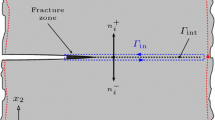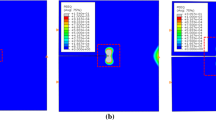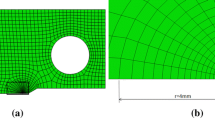Abstract
A finite element creep analysis of a center crack specimen has been carried out under small scale to extensive creep conditions. The crack was assumed to be stationary. Several constitutive models were used; these consisted of elastic, power-law creep with and without rate-independent plasticity, as well as one which also included primary creep. The mechanics basis of the C t parameter, which has been proposed for correlating creep crack growth behavior under conditions ranging from small scale to extensive creep, is explored.
For the aforementioned specimen geometry, consideration of primary creep seems to explain the differences between the measured and previously calculated load line deflection rates based on power-law creep only. It is also concluded that in small scale creep, C t does not characterize the instantaneous crack tip singular stress field, but it accurately characterizes the rate of expansion of the crack tip creep zone regardless of whether primary or secondary creep is occurring. This result provides a rationale for using C t to correlate creep crack growth rates even in the presence of significant primary creep deformation.
Résumé
On a procédé à une analyse par éléments finis du fluage d'une éprouvette comportant une fissure centrale, sous des conditions allant du fluage à petite échelle jusqu'à un fluage important. On suppose que la fissue est stationaire. Divers modèles ont été utilisés, à savoir la loi de fluage élastique ou parabolique, avec ou sans plasticité indépendante de la vitesse, ainsi qu'une loi incluant également le fluage primaire. On a étudié la base mécanistique du paramètre C t, proposé pour relier le comportement de la croissance de la fissure de fluage sous des conditions entraînant un fluage depuis une petite échelle jusqu'à une grande échelle.
Pour la géométrie citée, les différences entre les vitesses de variation de la courbe de la charge, mesurées et précédemment calculées en se basant sur la seule loi parabolique de fluage, semblent applicables par la prise en considération du fluage primaire. On conclut également que lors de fluage à petite échelle, C t ne caractérise pas le champ singulier de contraintes instantanées à l'extrémité de la fissure, mais plutôt, et de maniére sûre, la vitesse d'extension de la zone de fluage à l'extrémité de la fissure, qu'il y ait fluage primaire ou fluage secondaire. Ce tésultat fournit une base d'utilisation de C t pour connaître les vitesses de croissance d'une fissure de fluage, même en présence d'une déformation de fluage primaire significative.
Similar content being viewed by others
References
A.Saxena, in ASTM STP 905, J.H.Underwood et al. (eds.) American Society for Testing and Materials, Philadelphia (1986) 185–201.
K. Ohji, K. Ogura and S. Kubo, Japan Society of Mechanical Engineers, No. 790–13 (1979) 18–20 (in Japanese).
H. Riedel and J.R. Rice, in Fracture Mechanics-Twelfth Conference, ASTM STP 700 (1980) 112–130.
J.W.Hutchinson, Journal of the Mechanics and Physics of Solids 16 (1968) 13–31.
J.R.Rice and G.F.Rosengren, Journal of the mechanics and Physics of Solids 16 (1968) 1–12.
J.L.Bassani and F.A.McClintock, International Journal of Solids and Structures 17 (1981) 479–492.
J.D. Landes and J.A. Begley, Mechanics of Crack Growth, ASTM STP 590 (1976) 128–148.
R. Elhers and H. Riedel, Advances in Fracture Research, Vol. 2, Fifth International Conference on Fracture, Cannes (1981) 591–698.
J.L. Bassani, D.E. Hawk, and A. Saxena, “Evaluation of the C t Parameter for Characterizing Creep Crack Growth Rate in the Transient Regime,” Third International Symposium on Nonlinear Fracture Mechanics, Knoxville (Oct. 6–8, 1986).
C. Leung, D.L. McDowell, and A. Saxena, “A Numerical Study of Nonsteady State Creep at Stationary Crack Tips,” Third International Symposium on Nonlinear Fracture Mechanics, Knoxville (Oct. 6–8, 1986).
S.B.Biner, D.S.Wilkinson, and D.Watt, Engineering Fracture Mechanics 21(2) (1985) 315–328.
R.B.Stonesifer and S.N.Atluri, Engineering Fracture Mechanics 16(6) (1982) 769–782.
F.W. Brust, “The Use of New Path Independent Integrals in Elastic-Plastic and Creep Fracture,” Ph.D. thesis, Georgia Institute of Technology, December 1984.
A.Saxena and P.K.Liaw, “Remaining Life Estimation of Boiler Pressure Part-Crack Growth Studies,” EPRI-CS-4688, July 1986, Electric Power Research Institute, Palo Alto, CA.
V.Kumar, M.D.German, and C.F.Shih, “An Engineering Approach to Elastic-Plastic Fracture Analysis,” EPRI NP-1931, 1981, Electric Power Research Institute, Palo Alto, CA.
R.M.McMeeking, Journal of the Mechanics and Physics of Solids 25 (1977) 357–381.
R.M. McMeeking and D.M. Parks, in Elastic Plastic Fracture, ASTM STP 668 (1979) 175–194.
C.F.Shih and M.D.German, International Journal of Fracture 17 (1981) 27–43.
ABAQUS Finite-Element Code, Hibbitt, Karlsson and Sorenson, Inc., Providence, Rhode Island.
I.C.Cormeau, International Journal of Numerical Methods in Engineering, 9 (1975) 109–127.
H.Riedel, Journal of the Mechanics and Physics of Solids 29 (1981) 35–49.
Author information
Authors and Affiliations
Rights and permissions
About this article
Cite this article
Leung, CP., McDowell, D.L. & Saxena, A. Consideration of primary creep at a stationary crack tip: Implications for the C t parameter. Int J Fract 36, 275–289 (1988). https://doi.org/10.1007/BF00017204
Received:
Accepted:
Issue Date:
DOI: https://doi.org/10.1007/BF00017204




